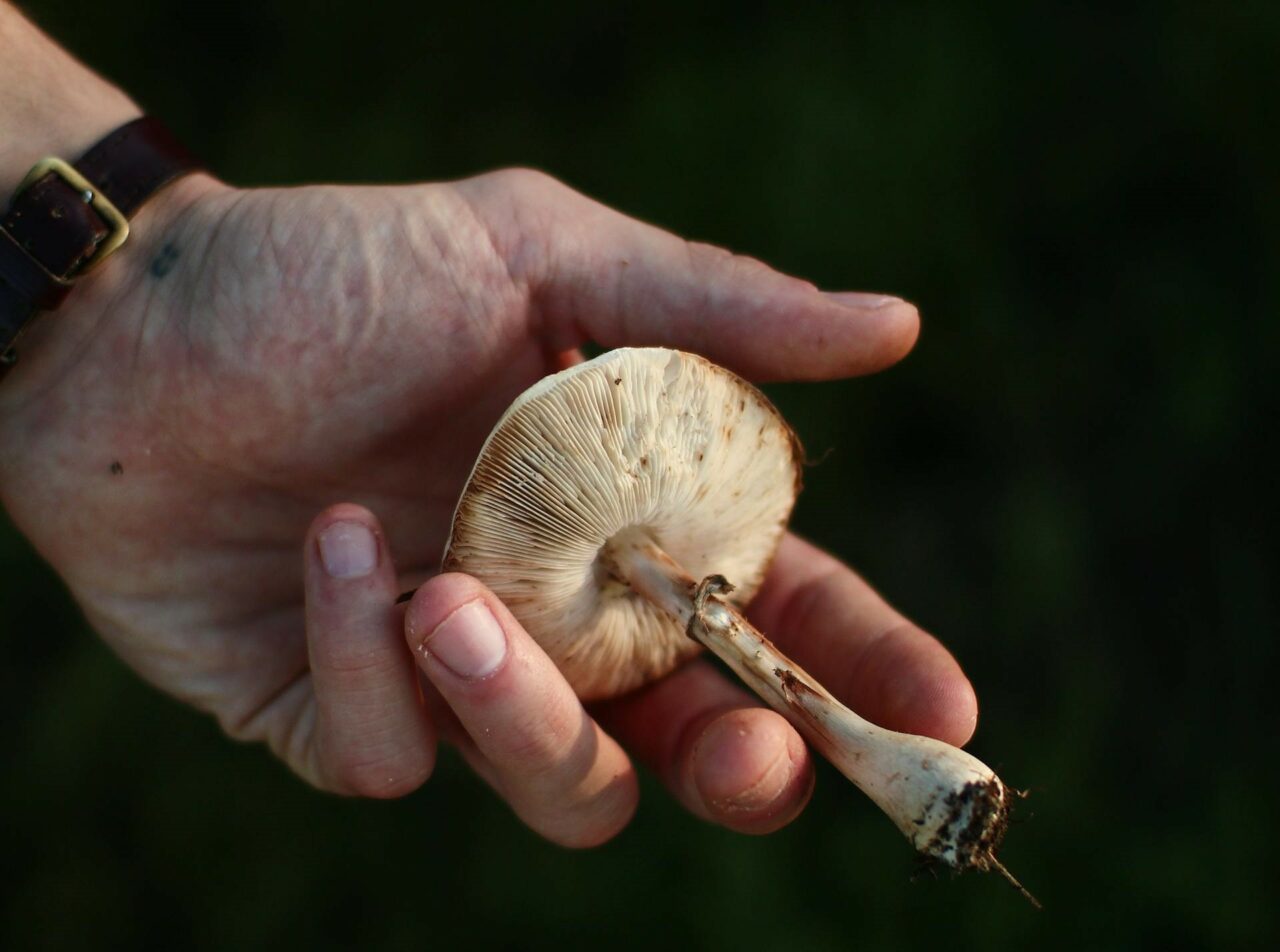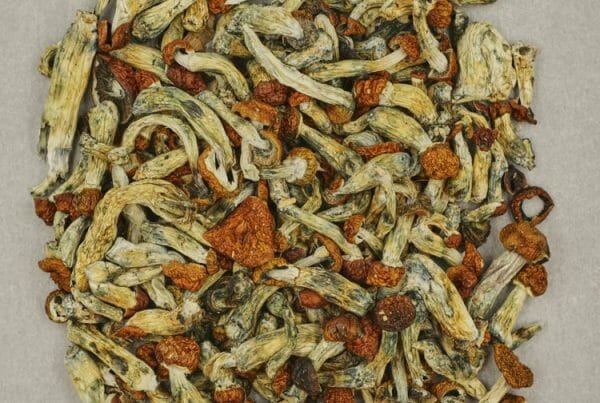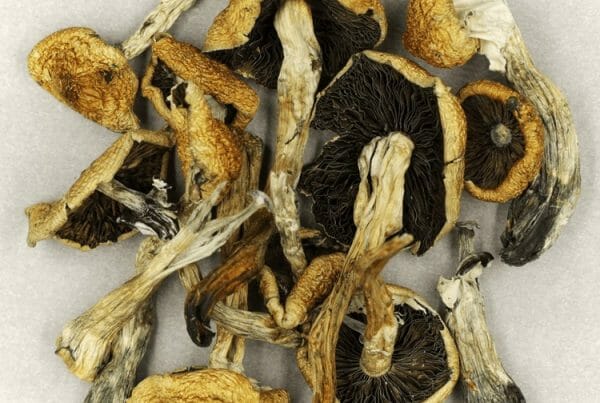Psilocybin mushrooms are a classic psychedelic and a serotonin 5-HT2A receptor agonist, similar to LSD. Researchers are studying these in psilocybin-assisted therapy for mental health conditions such as emotional distress linked to major depression, anxiety, cluster headaches, and migraines.
To understand how shrooms help with this condition, it’s essential to research how they break down in the body. This process allows researchers and users to see how the active compound produces psychological and therapeutic effects. This article offers a basic overview of psilocybin’s pharmacology and pharmacokinetics.
Table of Contents

Key Takeaways:
- Fifty percent of orally ingested psychedelic fungi are absorbed and distributed throughout the body.
- The compound of fungi undergoes dephosphorylation by the enzyme alkaline phosphatase, with the liver being the main site for this process.
- In humans, the body excretes about 3.4% as a free form within 24 hours, while it eliminates most of it as the stable metabolite.
Pharmacokinetics – What Is It?
Pharmacokinetics (PK) studies how the body processes substances, like medications, through exposure. It’s related to, but different from, pharmacodynamics, which focuses on the compound’s reactions to you. PK looks at four key areas: absorption, distribution, metabolism, and excretion (ADME).
Understanding these processes helps healthcare providers prescribe medications that offer the most benefit with the least risk. It also allows them to adjust treatments based on each patient’s unique physiology and lifestyle.
How Do Pharmacokinetics Relate to Psilocybin?
Psilocybin and psilocin – the prevalent active compounds found in certain magic mushroom species have gained huge attention from researchers and patients. Pharmacokinetics sees how psilocybin-containing mushrooms move through the body. It also helps everyone to know their potential effects, medicinally or recreationally.
People refer to these compounds by various names, such as “magic,” “psychedelic,” “medicinal,” or “sacred.” Consumers ingest the fungi containing these compounds, with concentrations varying widely based on the mushrooms’ species, origin, size, growing and drying conditions, and age.
Although naturally occurring, scientists can also synthesize these shrooms in a lab. Natural and synthetic versions have low toxicity. There may be some minor inconveniences, like nausea or vomiting.
Despite the physical effects, the compounds showed potential therapeutic benefits due to their safety profile and lack of addictive properties. Researchers have explored its use in psychotherapy, particularly as an anxiolytic and antidepressant.
The 4 Stages of Pharmacokinetics
Psilocybin is inactive on its own and acts as a prodrug, converting it into its active form, psilocin. Enzymes like alkaline phosphatase facilitate this conversion and allow psilocin to be absorbed, circulate throughout the body, and distribute into various tissues. After oral administration, research can not detect psilocybin in circulation, feces, or urine.
Absorption
Absorption is the process by which the substance enters the bloodstream from its point of administration. This affects how quickly and effectively the compound reaches its target, such as the plasma. The oral route is the most common route of administration. Some tried inhalation but it is not as effective as consuming it orally.
Absorption also involves the release of the strain from its dosage form during oral ingestion. This can be affected by factors like the substance being delayed in the throat or esophagus, potentially slowing its results or causing irritation. Once in the stomach, the acidic environment may start to break down the substance before it reaches the bloodstream.
Studies in animals show that only about 50% of orally administered psychedelics are absorbed and distributed throughout the system.
Factors Affecting the Absorbing Processes
Several factors can influence the absorption process. This leads to variations in the onset, intensity, and duration:
- Stomach Contents: A full stomach can delay the procedure by slowing the onset of outcomes. An empty stomach has a faster absorbing process.
- pH Levels: Acidic environment in the stomach is favourable for rapid dephosphorylation.
- Psilocybin Mushroom Forms: Raw fungi may have different absorption rates compared to capsules or extracts. The former breakdown faster.
The phosphate group on psilocybin is highly polar. This polarity, combined with the positively charged amine group, makes the molecule zwitterionic and more water-soluble than psilocin. Without the phosphate group, psilocin becomes more lipid-soluble, metabolically available, and easier to absorb in the intestines.
Metabolism
Metabolism is the body’s way of processing strains into compounds that can be easily excreted. This involves making the shroom more water-soluble for renal clearance. This is needed to activate the impact.
Metabolism mainly occurs in the liver through two phases:
- Phase I (CYP450 Reactions): Converts the hallucinogenic drugs into polar metabolites via oxidation.
- Phase II (UGT Reactions): Conjugates these metabolites to make distribution easier.
- These processes inactivate the drug and prepare it for excretion through urine or bile.
After absorption, the compound undergoes a metabolic conversion in the liver. Dephosphorylation is the primary metabolic procedure where psilocybin converts to psilocin by the enzyme alkaline phosphatase. The liver is the primary site for this conversion. This can also undergo secondary metabolic processes that produce various byproducts.
Psilocin then undergoes significant first-pass Phase I metabolism in the liver to form different metabolites:
- 4-hydroxyindole-3-acetaldehyde
- 4-hydroxytryptophol
- 4-hydroxyindole-3-acetic acid (4-HIAA)
Phase II metabolism is catalyzed by the UDP-glucuronosyltransferase enzyme family, with UGT1A10 being the main pathway. Psilocin-O-glucuronide is the primary urine metabolite, with 2% to 4% of psilocin eliminated unchanged.
Distribution
Distribution refers to how the spread throughout the system after entering the bloodstream. Psilocin is lipophilic, so it can cross the blood-brain barrier to get to the central nervous system.
The product’s properties, such as its size, polarity, and ability to bind to proteins, as well as the individual’s physiology—including hydration levels and body composition—influence this.
The aim is to achieve an effective concentration at the target site. For effectiveness, it must reach the intended area, defined by the volume of distribution, and remain unbound to proteins so it can actively interact with its receptor.
Factors Affecting the Distribution Processes
Several factors can influence distribution:
- Body Fat: Compounds may accumulate in fatty tissues, potentially prolonging outcomes.
- Age: Metabolic rates and body composition can vary with age.
The reactions will manifest within 20-40 minutes after consumption, with peak levels reached in about 80-100 minutes. The effects of magic mushrooms last 4-6 hours.
Distribution to the Brain
An early preclinical study in two species showed that its binding affinity sequence is 5HT2A > 5HT1A > 5HT2B [23]. It aslo binds to receptors of dopamine D1, 5HT1E, 5HT5A, 5HT7, 5HT6, D3, 5HT2C, and 5HT1B.
It acts as a partial agonist at the 5HT2A receptor, with about 40% efficacy. Its partial agonist activity at 5HT1A autoreceptors is responsible for its psychedelic impact.
The observed correlation between increased dopamine levels and sensations of depersonalization and bliss may explain the mood-elevating and psychotomimetic experience. Hallucinogens work through changes in neurochemistry and receptor activity. It enhances 5HT2A agonist activity by increasing BDNF synthesis in the hippocampus to increase neurogenesis and reduce conditioned fear-related behaviours.
Excretion
Excretion is the body’s process of removing a compound through the kidneys but also via the lungs, skin, or gastrointestinal tract. In the kidneys, a naturally occurring psychedelic drug is filtered in the glomerulus or secreted in the tubules, with some reabsorption complicating the process.
The main compound has a half-life of around 160 minutes, while psilocin’s half-life is about 50 minutes. In animal studies, this is mainly excreted in urine (65%) within 8 hours of ingestion, with smaller amounts found in bile and feces.
In humans, approximately 3.4% is excreted as free form within 24 hours, with most of it eliminated as the more stable metabolite psilocin-O-glucuronide. This stability allows for longer detection of the compound in urine samples.
There are two main types for substance excretion:
- Zero-Order Kinetics: Eliminated at a constant rate, regardless of concentration.
- First-Order Kinetics: Elimination rate depends on the drug concentration.
Most psychedelic drugs follow first-order kinetics, with steady-state concentrations reached after four to five half-lives. Complete elimination also occurs after four to five half-lives.
Browse Hallucinogenic Mushrooms Selection
Metabolism of fungi can differ on the type. Buying from online sources like Zoomies Canada will help avoid consuming a poisonous mushroom. Certain mushrooms, like Agaric mushrooms, can be intense and lead to bad effects. Before taking magic mushrooms, make sure that you are sourcing them from reliable dispensaries and not from shady street dealers or foraging.
| Feature | Enigma | Full Moon Party | Gold Member |
| Strain Type | Psilocybe Cubensis OMNI | Psilocybe cubensis (Thai Koh Samui) | Psilocybe cubensis |
| Potency | Extremely high; 3.8% tryptamine content | Moderate to high | High potency |
| Visual Characteristics | Blob-like formation; cauliflower/brain-like appearance | Traditional cubensis look; moderate size | Long, thick white stems; golden caramel caps; heavy blue bruising |
| Effects | Considered the most potent; very intense effects | Strong mind high; delayed onset with strong visuals | Strong visuals and euphoria |
Explore Psilocybin Mushroom Use Online
Understanding the shroom’s pharmacokinetics process is essential for medical professionals, researchers, and recreational users. You can now make informed decisions about dosing and timing while minimizing its risks.
Discover the perfect psychedelic for you at Zoomies Canada. Whether you’re looking for a relaxing trip or something deeper, we have a range of products to meet your needs. Enjoy safe, high-quality shrooms without worrying about unreliable sources or poisonous mushrooms.
Discover premium magic mushrooms Canada and elevate your journey to new heights.
Frequently Asked Questions
Are there any known interactions between shrooms and other medications?
These products can interact with certain medications, particularly those affecting serotonin levels, such as antidepressants (SSRIs). SSRIs and SNRIs seem to reduce the effects compared to non-serotonergic antidepressants. This dampening effect may persist for up to three months after discontinuing the antidepressant.
Do all psychedelics follow the same pathway as psilocybin?
No, each substance has a unique structure that requires different breakdown processes to become active, and they bind to different receptors in the body. The route of administration also affects the absorption of each psychedelic. While the basic principles of absorption, metabolism, and distribution still apply, the specific pathways and effects vary for each substance.
Can the shroom’s form influence the pharmacokinetics?
Yes, the form (fresh, powdered, or dried mushrooms) can affect the absorbing process rate. For example, powdered forms might be absorbed more quickly than whole dried ones due to faster dissolution.
Related Articles:





